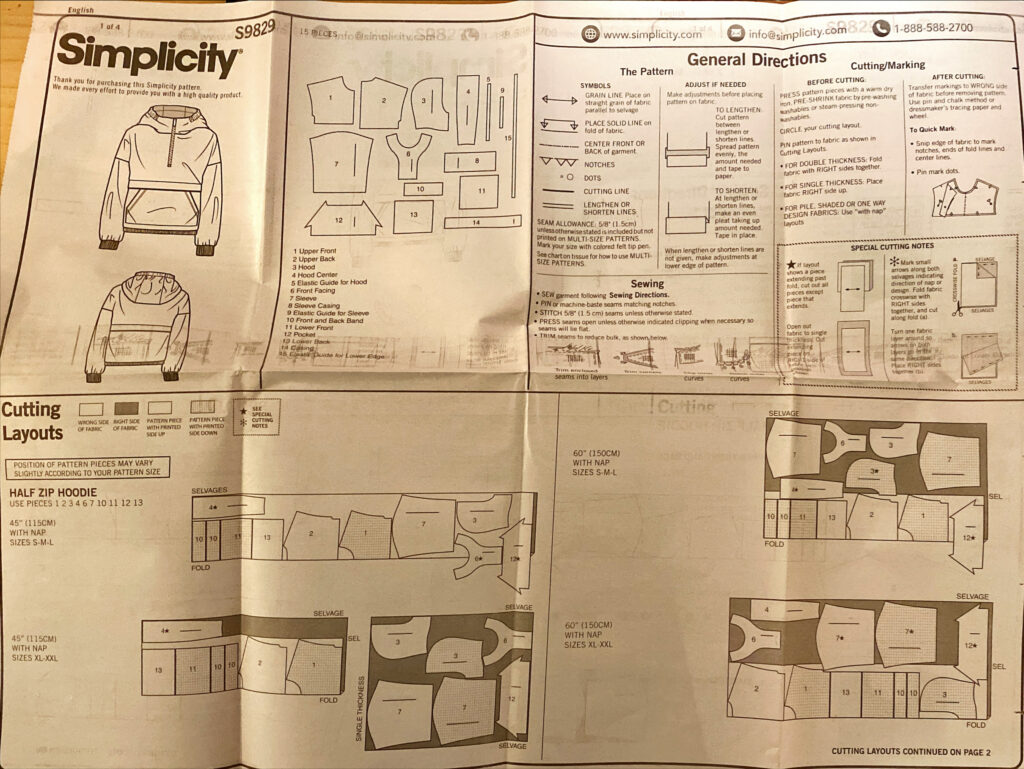This week, the first patterns for my final project from Amazon showed up at my door. I selected three patterns: a short-sleeved dress shirt, pants set, and an exciting and uncomplicated hoodie design. I initially picked all the designs because they looked cool and were the right price (around $15 each). As far as simplicity goes, I was mistaken. Upon opening the packaging and examining the contents, I looked at what I can only describe as the blueprints to build the Mars rover. There were symbols I had never seen and language that was new to me. The instructions used a lot of sewing jargon that made it challenging to understand, and there were lines and symbols… everywhere. Taking a deep breath, I sat momentarily and gathered myself. “Back to the drawing board,” I thought as my research process started anew.

A Brief History of Patterns
Sewing patterns can be traced back to the 18th century. Dressmakers hired by wealthy clients would start by draping fabric over a dress form, similar to a mannequin. The tailor would then take the fabric and lay it out, carefully tracing the design on the fabric and then keeping it so they could quickly make and produce similarly cut dresses. Because the designs were then created and owned by the tailor who produced them, they were often guarded and kept secret. This was to create scarcity in the market and guard innovative designs so that if you wanted a specific dress cut, you would have to hire that tailor. Moving into the early 1800s, dress magazines saw an opportunity in the market and began to publish simple patterns and sell them with the magazine. This approach led to higher magazine sales and allowed women to create their own more fashionable clothing from more modern cuts. Coupled with at-home sewing machines becoming more popular and affordable, the idea was very popular. However, it wasn’t until 1863 that the Butterick Publishing Company revolutionized the pattern-making industry, creating models of the same patterns we use today. That is one pattern with outlines that can be made in several sizes. The innovation of the graded pattern allowed women to purchase one pattern, for example, a dress, and then create multiple garments of all different sizes. This was an excellent option for families on a budget and with growing children. Quickly, the company became very popular.
Future Innovations in Pattern Making
What do the patterns of the future look like? Although garment design has become more streamlined and accessible, people will always need to have access to clothes and patterns for a simplistic design. Reading online forums, the consensus is that AI will hold the keys to pattern-making in the future. This could be done by analyzing garments worn by one’s favorite designer and quickly replicating a pattern. Another potential avenue would be to input your measurements into a database and then design your garments with 3d imaging with the help of AI. For example, using a prompt like, “I’m going to a party and want a chic, futuristic dress inspired by Audrie Hepburn’s style. Then, with the assistance of an AI tool, you would design the garment and create a downloadable file for you to print and cut. Although the future of pattern-making is exciting, it does raise ethical questions about who would own these designs. Would it be moral, for instance, to print and copy a dress from your favorite designer without their permission? Perhaps the tailors from the 18th century had it right by hoarding all their designs to prevent mass production of high fashion garments. However, this raises other questions about the classism inherent in the fashion industry and the affordability of designs.
Conclusion
After my foray into the world of pattern-making, I took stock of my situation. My sewing partner Anne has ended her trip and is now back in Canora. We texted briefly, and she suggested it was time to learn the sewing language. If I wanted to make headway, I would have to learn to decode this pattern, and the best place to learn would be online. So, tonight, I found an excellent YouTube video. The creator began explaining the symbols commonly found in sewing patterns, their meaning, and why they exist. The video was helpful and gave me the confidence to start working on the project. It’s time to learn another language and begin making my garment.
Citation
Information for the paragraphs on a history of patterns, and patterns and the future was found on this site